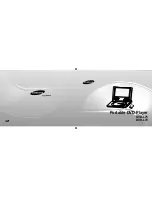
11
If in the
INTERNAL SWEEP
mode (
INT LED
lights), pressing the
SWEEP INT/EXT
button will engage the
EXTERNAL VCG
mode. By engaging this mode, the
EXT LED
lights
,
and
INT LED
stops lighting.
If in the
FREQCOUNTER
mode (
COUNTER LED
lights), pressing the
COUNTER/VCG SWEEP
button will engage the mode
selected by the
SWEEP INT/EXT
button. If the button activates the
INTERNAL SWEEP
, the case will be the same as described in
the previous paragraph otherwise the button will activate
EXTERNAL VCG
mode.
3.2.1.2. Selecting output waveform.
Pressing one of the “
WAVEFORM
” buttons:
SINE WAVE SELECT
,
SQUARE WAVE SELECT
or
TRIANGLE WAVE
SELECT
, will engage one of the desired waveform: sine, square or triangle respectively. The current selected type of waveform will
have their corresponding LED lighted.
The shape of the waveform can be changed by modifying the duty cycle parameter (see example from section 3.2.5.4, where there are
displayed waveforms, with different duty cycle parameters).
3.2.1.3. Selecting the frequency.
The output frequency can be set on the
OUTPUT
jack between 0.00Hz and 10.000MHz. See section 3.1.1 for details regarding setting
of the frequency value. This will also set the output frequency of the
TTL/CMOS
style signal outputted on
TTL/CMOS
jack.
To set certain frequency values it is preferable that the
VCG/SWEEP
input jack is disconnected from any source signal before pressing
the range buttons or turning the
FREQUENCY
knob. This way the
VCG/SWEEP
input jack does not affect the setting of the current
output frequency.
After setting the frequency using front panel controls, the selected output frequency can be modified by applying positive DC levels on
the
VCG/SWEEP
input jack. The DC levels must be within [0V, 10.0V] range, causing the output frequency to decrease with a ratio of
the original value with the ratio varying between 1:1 and 1:100, respectively.
ATTENTION:
Appl
ying in excess DC levels above +10.0 V on VCG SWEEP input jack can damage the input.
Applying certain positive DC levels on
VCG/SWEEP
jack will decrease the output frequency; the resulting fixed output frequency
represents a fraction of the original output frequency (see example 1).
Changing the DC level in a ramp style will cause a frequency sweep on the main signal output, the
OUTPUT
jack (see example from
section 3.2.5.1).
3.2.1.4. Selecting the level.
The signal’s output level on
OUTPUT
jack can be set using the
OUTPUT LEVEL
knob between 10mV
p-p
and 10.0V
p-p
(on 50
Ω
load),
regardless of the waveform type. See section 3.1.2 for details regarding setting of the level value (see example from section 3.2.5.1).
The –20dB LED will be lighted if the –20dB attenuation is engaged on the main signal output path.
3.2.1.5. Selecting the offset.
The DC level added to the output signal on
OUTPUT
jack can be set using the
DC OFFSET
knob between – 5.000V and + 5.000V (on
50ohm load), regardless of the waveform type. See section 3.1.3 for details regarding setting of the offset value (see example from
section 3.2.5.1).
The
DC OFFSET LED
lights if the offset value is not 0.
3.2.1.6. Selecting the duty cycle.
The duty cycle of the output signal on the
OUTPUT
jack can be set using the
DUTY CYCLE
knob, between 0% and 100%, regardless
of the waveform type. See section 3.1.4 for details regarding the setting of the offset value (see also examples 1, 2 and 3 on section
3.2.1.8).













































